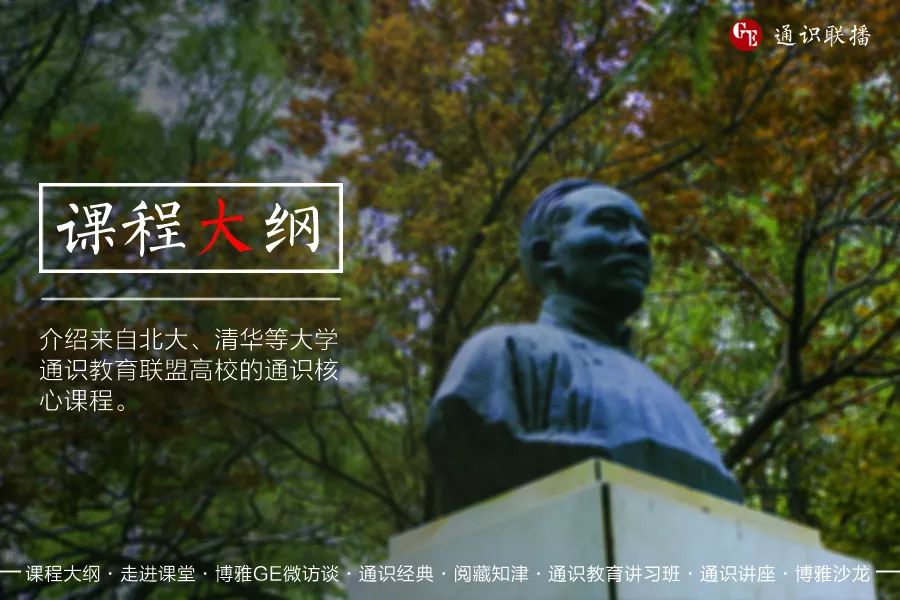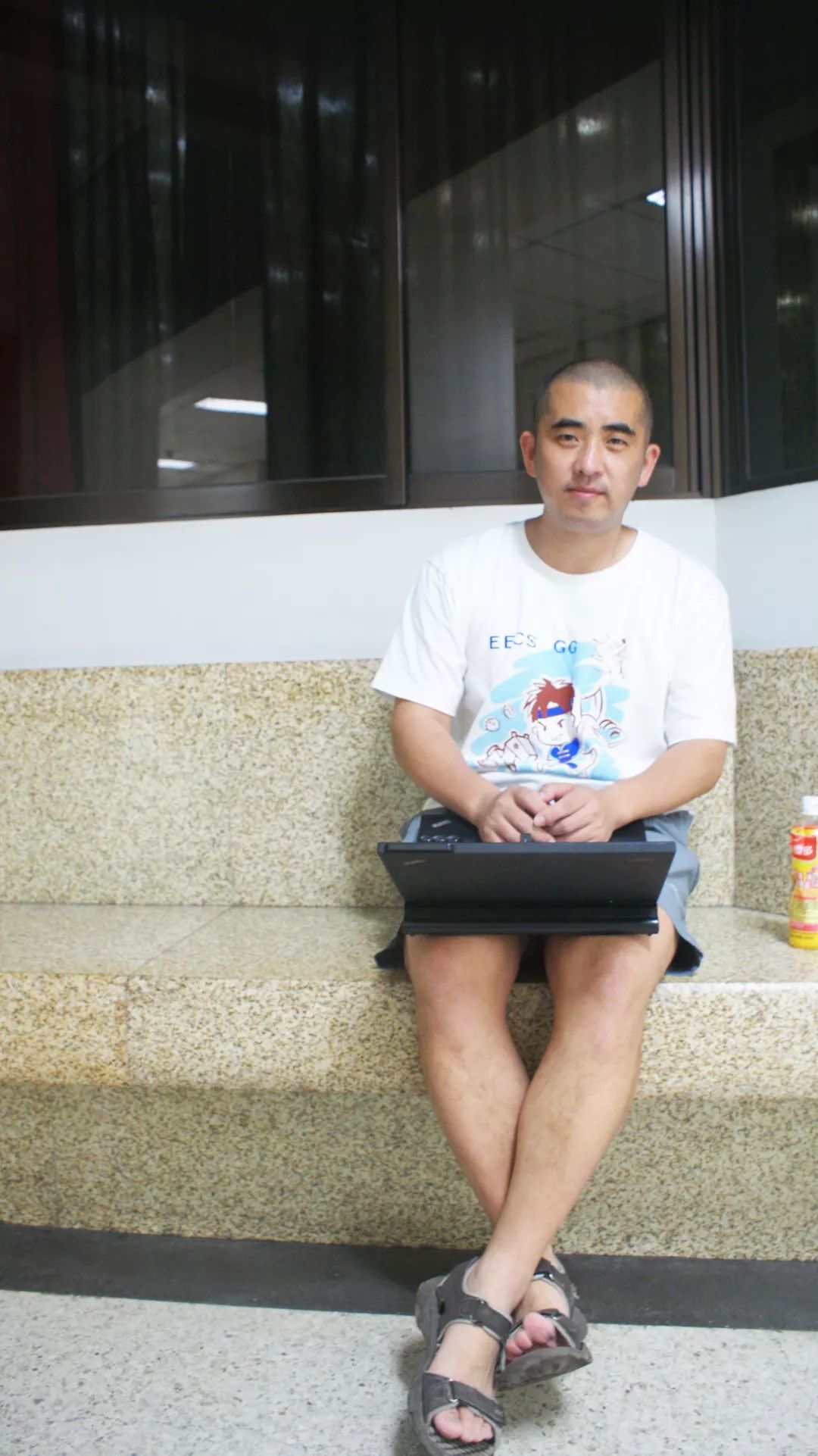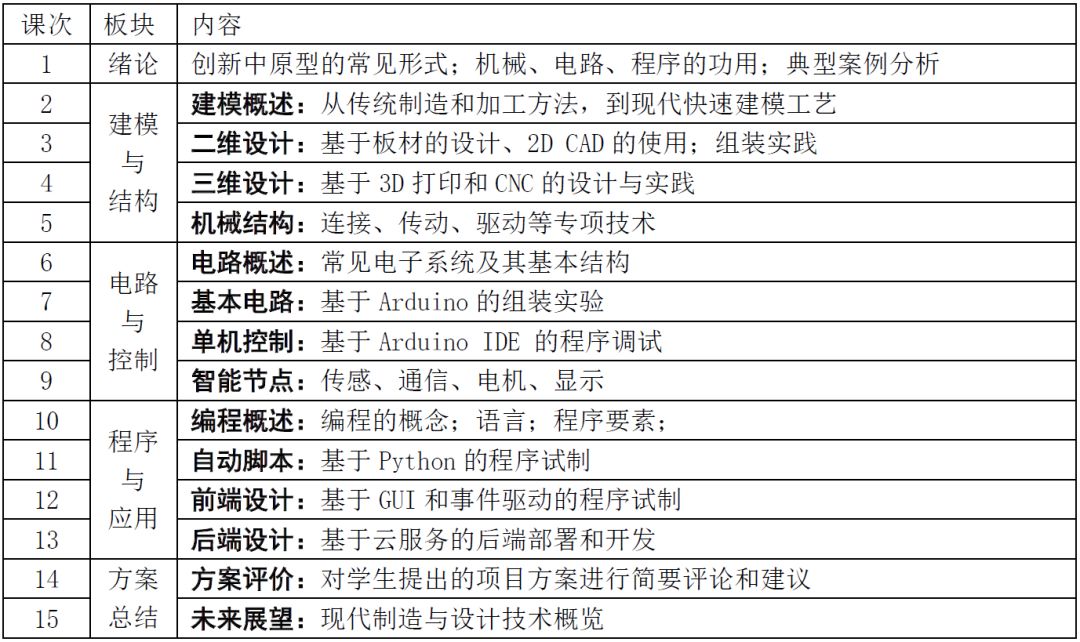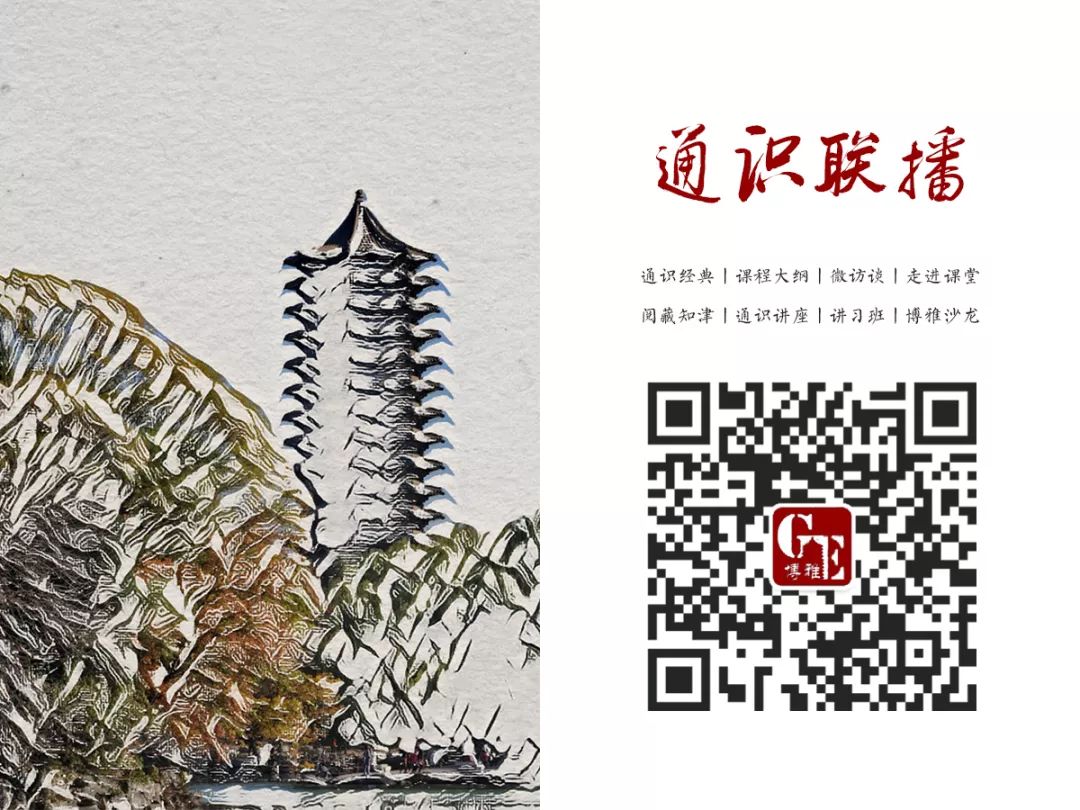
This article presents the course syllabus and introduction of the core general education course “Innovation and Rapid Prototyping” offered by Professor Chen Jiang from the School of Information Science and Technology at Peking University this semester.
In this course, Professor Chen focuses on the “Prototyping” stage of innovative product development, covering three main areas: Models and Structures, Circuits and Control, Programs and Applications. Additionally, this course lays a foundation for modern design and production through hands-on practical experience for students from various majors. Since its inception, the course has been well-received and praised by students across the university, and it has garnered attention from the Yuanpei and Biological Science colleges. After slight adjustments, Professor Chen will also offer this course specifically for the relevant colleges.
Vol.985
Course Syllabus
Innovation and Rapid Prototyping
Course Syllabus
Offering Department: School of Information Science and Technology
Instructor: Chen Jiang
Credits: 2
Instructor Introduction

Chen Jiang, Associate Professor at the School of Information Science and Technology, Peking University. He works at the Modern Communication Research Institute and serves as an executive director of the Teaching and Textbook Research Association for Circuit and Signal Systems in Higher Education, a member of the China Communication Theory and Signal Processing Committee, and an expert in the Asia-Pacific eSports Federation Think Tank.
Courses taught: Electronic Circuit Analysis and Design, Basics of Microelectronics and Circuits, Computer Application Topics, Innovation and Rapid Prototyping, Innovation Engineering Practice (Internship), Introduction to Video Games, among others. In recent years, he has been invited to give nearly a hundred lectures on topics such as teaching technology, course production, and innovative education.
Research areas: Wireless communication and circuit systems. He has participated in and led research projects including: IMT-A National Major Science and Technology Project, drafting national standards for terrestrial digital television transmission systems, and several national defense 863 projects.
Awards: In 2010, he received the Peking University Teaching Excellence Award; in 2012, he received the Peking University Huang Tingfang/Xinhe Teaching Award; in 2012, he received the first Wang Chu Teaching Award from the Department of Electronics at Peking University; in 2015, he received the Peking University Teaching Excellence Award; in 2015, he was named one of the Top Ten Teachers at Peking University; in 2019, he received the Peking University Teaching Excellence Award.
Course Introduction
In the process of product development and innovation, physical production is often involved. However:
-
The disciplines, methods, and technologies involved in “product innovation” are very broad;
-
Even if limited to the “development” phase, the engineering problems involved can be complex and varied.
-
It is impossible to cover all the various skills that may be used in a practical course on the “development process”.
Based on the experience and observations of the teaching team over many years guiding students in creation, internships, and competitions, most student innovation projects include parts or all of the following three aspects: model making, circuit building, and program writing. Many student teams, when encountering these types of production problems outside their major, often have two tendencies: one is to feel helpless and afraid to try, falling into a dilemma; the other is to be overly confident and rush into it, resulting in a mismatch or extremely low efficiency, ultimately leading to a hasty conclusion of the project.
Thus, notices like “just need a programmer” frequently appear on BBS or social media. However, the chances of successful recruitment are also very low—two possible reasons are: the startup team lacks experience and does not have a clear understanding of the difficulty of the production problems encountered in innovation/entrepreneurship, so the project goals are somewhat unrealistic, lacking sufficient foresight regarding the manpower, time, and costs required for development; or they lack accurate terminology to describe their project goals and needs, making it difficult to communicate with professional teams.
Through a semester of 15 class sessions, while it is impossible to become an expert in the relevant field overnight, after introducing the knowledge system of the relevant background and coupled with practical hands-on experience, the aim is to achieve:
-
A relatively comprehensive understanding of modern product manufacturing methods, forms of work, and development processes;
-
Understanding the performance and selection methods of common materials and auxiliary materials, structural construction, and manufacturing processes;
-
Understanding the relevant design processes, design tools, effectiveness and drawbacks, difficulty costs, and processing cycles;
-
A reasonable judgment of the feasibility and required development cycle of the innovative products that student teams are currently or will be working on;
-
For already established development projects, reasonably decompose the development procedures and propose possible and optimal trial production plans;
-
High efficiency in communication and exchange with professionals;
-
Understanding some basic skills in the professional fields often involved in innovation, and overcoming fears through a small amount of practice. Thus, having a mature judgment on whether certain production links in the project can be self-taught and self-produced;
-
If interest is sparked in certain areas of knowledge, then after a concise overview of the course, a relatively systematic starting point is established, allowing for self-guided deepening as needed after the course.
In summary, this course is based on the “Prototyping” stage of innovative products, encompassing three main areas: Models and Structures, Circuits and Control, Programs and Applications. Through specific hands-on practice, it lays a foundation for modern design and production for students of all majors.
Course Syllabus

Lesson 1
Introduction
-
Typical process of innovative product development, concept of prototypes
-
Typical forms of prototypes, analysis of advantages and disadvantages
-
Typical case analysis (5 cases): starting from structural block diagrams, analyzing the module functions, coordination, and trade-offs of mechanics, circuits, and programs
Lesson 2
Overview of Modeling: From Traditional Manufacturing and Processing Methods to Modern Rapid Modeling Techniques
-
Manual manufacturing and processing methods: sawing, filing, cutting, welding
-
Mechanical processing equipment and methods: various electric and pneumatic tools, functions and uses of machine tools
-
Modern processing techniques and methods: CNC; 3D printing; laser cutting and engraving
-
Concept of rapid prototype design
-
Indicators, pros and cons, and selection of processing technologies; characteristics and considerations of common materials
Lesson 3
Two-Dimensional Design
-
Modeling methods and typical cases based on sheet material splicing
-
Concepts and elements of two-dimensional CAD software
-
Introduction to QCAD software
-
Principles and operation of laser cutting machines
-
Practical model production based on QCAD and laser cutting (simple gyroscope, specimen box production)
Lesson 4
Three-Dimensional Design
-
Modeling methods and characteristics based on 3D printing
-
Elements and concepts of 3D production: models, slicing, supports, filling, base valves, etc.
-
Constraints of 3D printing: color, materials, strength, precision, production time, common errors and causes
-
Common 3D design software and their characteristics and comparisons
-
Practical three-dimensional model production based on TinkerCAD (simple integrated car, assembly-free bearing production)
-
CNC processing technology and its characteristics
Lesson 5
Mechanical Structure
-
Parts: standard parts, profiles, and custom-made parts
-
Introduction to connection technologies: joints, hinges, slots, limits, degrees of freedom, errors, forces
-
Introduction to transmission technologies: gears/rack, belts/synchronous belts, lead screws/worms, hydraulic/line control
-
Introduction to driving technologies: electric, pneumatic, etc.
-
Simulation in CAD software: transmission and assembly
-
Sketches/diagrams, three-view drawings, exploded views drawing, output, and specification explanation
Lesson 6
Overview of Circuits
-
Basic circuit knowledge
-
Block structure of common electronic systems (three cases from small to large)
-
Common small functional circuits: concepts and applications of microcontroller circuits and embedded systems
-
Typical innovative products centered around circuits: practical circuit case analysis
Lesson 7
Basic Circuit: Assembly Experiment Based on Arduino
-
Basic knowledge of Arduino circuits and their scalability
-
Arduino Nano-based circuit assembly experiment: breadboard + power bank + Dupont wires + other peripherals
-
Principles and applications of common display devices: LEDs; semiconductor lasers; LCD screens, etc.
-
Principles and applications of common sensors: light-sensitive, touch, magnetic field, thermal, ultrasonic distance, temperature and humidity, acceleration, etc.
-
Principles and applications of common actuators and control devices: DC motors, stepper motors, servos, and relays, etc.
-
Principles and applications of other modules: infrared remote control; RF card reader; piezoelectric ceramics, etc.
Lesson 8
Standalone Control: Program Debugging Based on Arduino IDE
-
Using Arduino IDE, progressively complete the programming for most experiments from the previous lesson
-
Students use their own laptops to install Arduino IDE and write programs under guidance
-
The vast majority of programs use tool libraries and are completed with minimal code
-
For a few more complex programs, templates or custom libraries (using very simple APIs) will be provided to students
Lesson 9
Intelligent Nodes: Sensing, Communication, Motors, Display
-
Providing more sensor baseboards: resistive, voltage type, I2C interface types, assembly and programming
-
Providing WiFi modules (ESP series), achieving interconnection and control under temporary WLAN AP in the classroom
-
Providing Bluetooth modules (transparent transmission modules), controlling microcontroller circuits with public version apps
-
Providing pre-made motors and structural components to complete remote control of a miniature (complete) 3DOF robotic arm
Lesson 10
Overview of Programming
-
Basic concepts of programming: from low-level languages to high-level languages; compiled languages and interpreted languages
-
Common types and evolution of programming languages
-
Basic elements of programming languages: arithmetic and logical operations; data movement; judgment jumps and branches
-
Advanced concepts of programming languages: data structures; structuring; scalability, libraries, and calling interfaces; object-oriented
-
Learning methods for programming: introduction to commonly used websites like GitHub, StackOverflow, etc.
Lesson 11
Automated Scripts
-
The concept of unattended and automated
-
Introduction to Python language, characteristics, and pros and cons
-
Practical programming based on Python: five exercises from simple to complex
-
Introduction to common Python libraries: data analysis; statistics; visualization; artificial intelligence
-
Practical concept analysis: sleep depth and wake-up; polling and interrupts; low power consumption; power considerations
Lesson 12
Front-End Design
-
Concept of graphical user interfaces, front-end and back-end
-
Concept of event-driven programs and typical program flows
-
Program development based on Python Kivy / Pygame: design and debugging of PC version
-
Interconnection and control between PC GUI programs and microcontroller systems: trial production experiments
-
Porting programs to Android platforms
Lesson 13
Back-End Design
-
Concept of network applications: servers, C/S architecture, virtual hosts, cloud
-
Introduction to common cloud services
-
Back-end design based on Alibaba Cloud
-
IoT development based on Alibaba Cloud: interconnection and control with microcontroller systems
Lesson 14
On-Site Plan Evaluation
-
Students propose innovative project goals (the instructor prepares three backup goals)
-
Students design and rehearse plans based on the knowledge learned this semester
-
Brief comments and suggestions on the project plans presented by students
-
Conducted in three rounds, each lasting about 30 minutes
Lesson 15
Future Prospects
-
Alternative product/prototype production: transformation and processing cases—utilizing, combining, and transforming common items
-
Differences between prototypes and formal products: production efficiency and yield, scale and cost, reliability and maintainability
-
Industrial design and quality: case studies of the four major design awards—Red Dot, IF, IDEA, Gmark, and future trend analysis
-
Overview of modern manufacturing and design technologies: direct laser manufacturing and other processing technologies
Textbooks and Reference Materials
Textbooks:
Self-compiled lecture notes (text and animated versions) + auxiliary video clips
Reference Materials:
Official tutorials for each software used in the course
Most suitable auxiliary video materials available online at the start of the course
Model material website: Thingiverse
Circuit production collection: Arduino Project Hub
Ziweizhi Edited / Qiuyang Proofread
General Education Broadcast
Exciting content continues

Please send submissions to: [email protected]